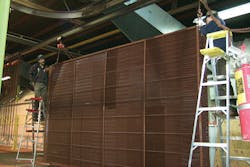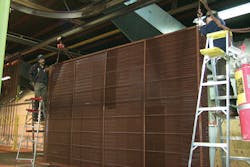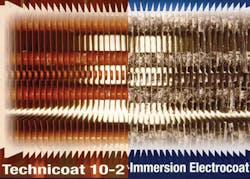Baton Rouge Wastewater Plant Finds Coating Solution
By Jack Sine
Like many wastewater plants, the Baton Rouge, Louisiana, facility has been fighting an ongoing battle with hydrogen sulfide’s effect on its air conditioning systems. But, because it’s located by the ocean, it also had to protect against damage from salt in the air.
Dangers of H2S and salt air
Hydrogen sulfide gas (H2S) forms in wastewater collection systems and can create septic conditions. Collection systems in warm climates that have a relatively flat grade or do not have flow-through velocities of two feet per minute or above create environments conducive to the growth of bacteria. Septic conditions occur when bacteria use all of the available oxygen when decomposing the organic material in wastewater. The bacteria reduce sulfur compounds, creating sulfides that combine with hydrogen atoms to form H2S gas.
This gas has a particularly destructive oxidizing effect on aluminum in air conditioning coils and copper tubing, making coating all these surfaces mandatory.
Salt air is similar, causing oxidation on all metal surfaces. This is why many HVAC contractors recommend coating every metal surface on air conditioning systems.
“What good is it to coat just the coil?” said Jason Watson, an engineer with Watson Mechanical Services, the HVAC engineering, sales, and service company which, for the last eight years, has been responsible for maintaining the HVAC systems in all of Baton Rouge’s municipal buildings. “The coil and tubing will still last longer than it would being uncoated because that is the most vulnerable part of an air conditioning system. But eventually the uncoated surfaces will crumble around the coated parts.
“My primary coating supplier guarantees its coating for 10 years, but what good does that do when the uncoated parts fail before the warranty is up?” he said.
In municipal settings, because of budget constraints, it is difficult to get additional expenses approved, so maintenance managers often agree to just coil and tubing coatings. “But when we first came on board,” said Watson, “Baton Rouge wastewater plant had a five-ton Rheems rooftop unit that was 8 years old and had all metal surfaces protected by AME-TechniCoat phenolic coating.” Eight years later, that system is still going strong. “To me, that makes a very solid economic argument for full coating of all metal services, especially considering the H2S and salt air environment,” he added.
What Kind of Coating?
There are numerous types of post-coats available in the United States: polyurethane, epoxy, phenolic, epoxy, polyelastomer, silica-based coatings, and others. Each has its own strengths and weaknesses.
Watson weighed in on his experiences with Baton Rouge wastewater facilities.
“Over the years, they have tried a variety of coil and copper tubing coatings, eliminating most of them because of one glaring fault - brittleness,” he said. “The natural vibration of an air conditioning system will crack most coatings over time and when we do maintenance service on a wastewater unit, we have to move parts of the system around to do our inspections and most of the coatings tend to crack. Not many of the coatings manufacturers offer field service and when they do, the facility managers don’t want to approve the expense, no matter how minimal.”
ADHESION AND FLEXIBILITY
A study conducted by the Army Corps of Engineers in 2016 in its Engineer Research and Development Center stated: “Phenolic coating adhered better to the aluminum and copper than did the other coatings tested, so phenolic coatings still show a better adhesion to aluminum and copper than the newer coating method/systems.”
“While phenols were first discovered in 1834, our engineers and scientists are constantly developing new formulations and applications, so our latest phenolic coating is really a new product,” said Christina Campbell, president of AME-TechniCoat. “In our case, we were able to patent our latest version which uses softeners so it goes on thin and smooth. And, instead of baking the coating as others do, we cure it so it will not crack and fail over time. It provides the flexibility HVAC mechanical engineers are looking for.”
But that’s only half the story, she said. “Adhesion is so important that preparation of the parts to be coated is as critical as the formulation of the coating itself. First, we designed our application area to be completely sterile and contaminant free. When parts arrive for coating, they are thoroughly inspected and then go through a multi-step cleaning process - chemical etching, monitored immersion, and a final top coat.” Next, she said, the parts are moved to a curing room before crating and shipping.
“For once the Navy agreed with the Army. Twelve years ago, they asked AME-TechniCoat to coat 1,100 AC coils for them in the ultimate salt air environment on the island of Guam. Recently they had to all be replaced because the AC units were crumbling around the still functioning coils.”
Energy Savings
“No matter what coating you’re using, you’re going to save energy,” said James Mottern, sustainability manager for AME-TechniCoat.
“The aluminum in the coil deteriorates over time due to oxidation in the hydrogen sulfide and salt environment.” The metal breaks down and becomes less efficient, he explained, requiring more energy to do the same job. That means the compressor is working harder and using more electricity. Then the system starts running hotter and the inside elements begin to break down.
The thickness of the coating is also a factor. “The thicker the coat the lower the efficiency. Our latest formulation, TechniCoat 10-2, is effectively as efficient as a new coil, less than one percent difference. It installs at a thickness of less than one millimeter. We guarantee our coatings for 10 years.”
“We have started to recommend Trane AC systems when the city buys from us,” said Watson. “And, like all the major AC manufacturers, Trane will have any and all parts of its systems coated with the material we recommend. We have had so much success with the AME phenolic coatings, and the Baton Rouge wastewater management has no problem with that because of the success we have had in recent years.”
About the Author: Jack Sine is a freelance writer specializing in environmental issues and the chemical, power, flow measurement and HVACR industries. He can be reached at [email protected] or by phone at (845) 831-6578.


